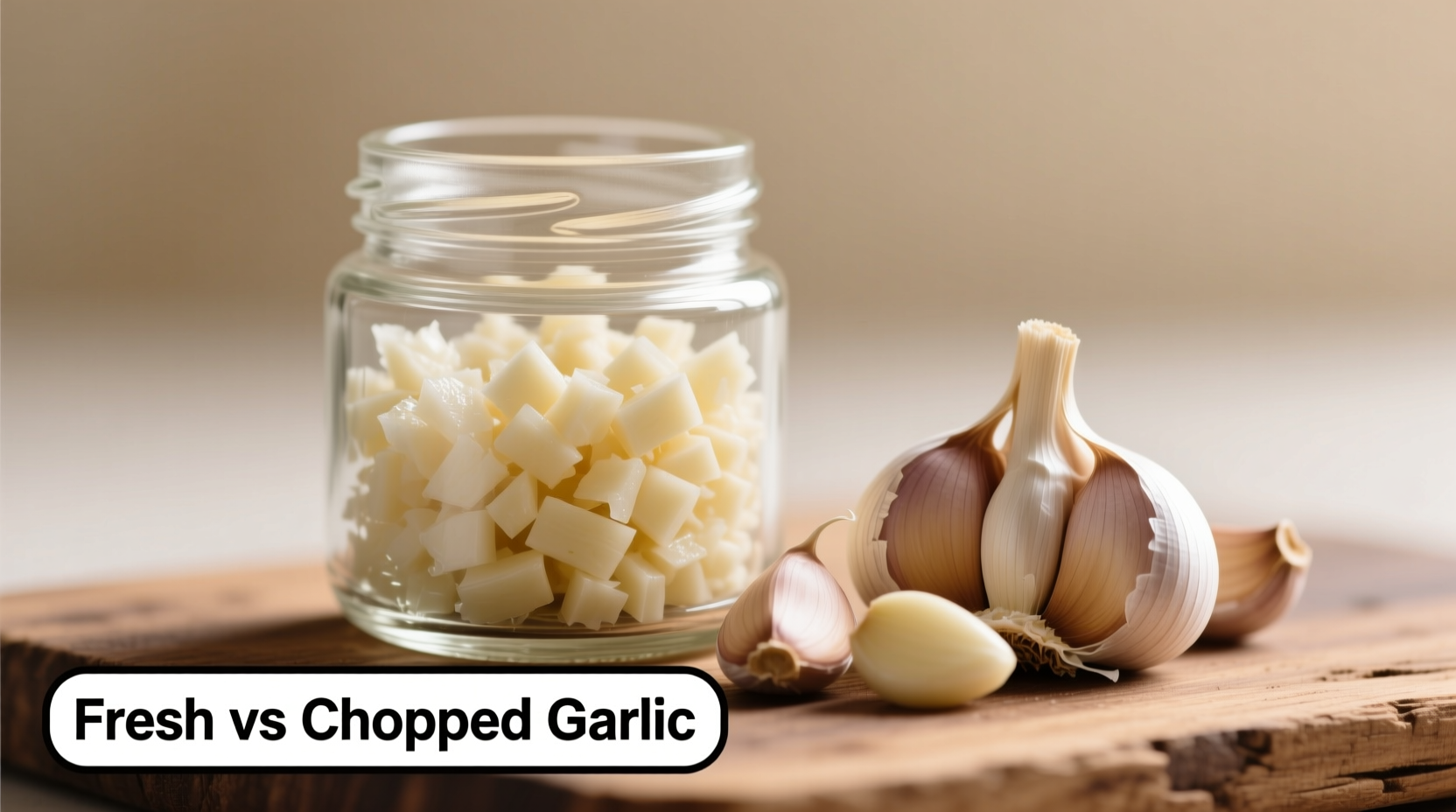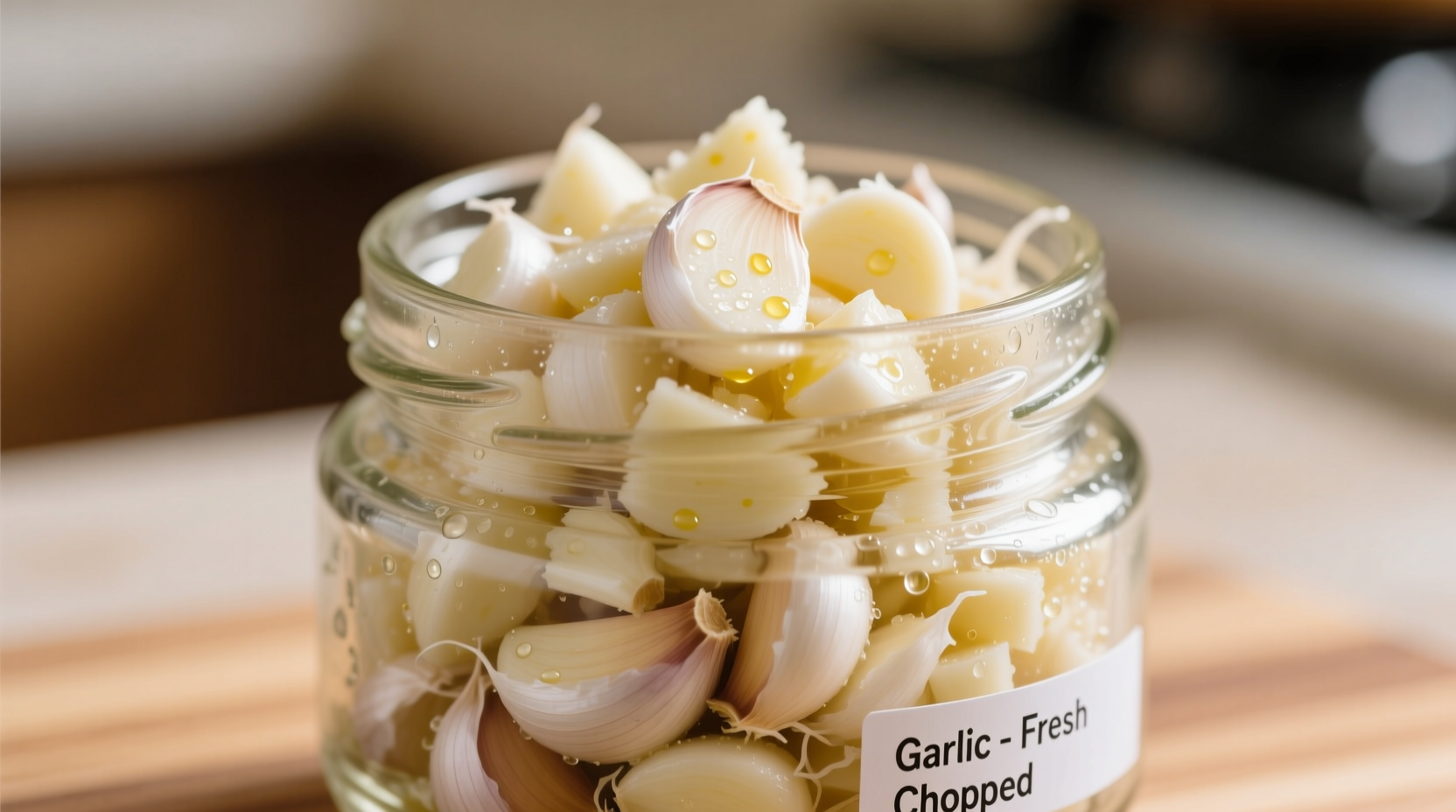Ever wondered whether that convenient jar of chopped garlic deserves a permanent spot in your pantry? As a professional chef who's tested hundreds of preserved ingredients across Michelin-starred kitchens and home test kitchens, I've discovered the nuanced reality behind this kitchen staple. This guide cuts through the marketing claims to deliver science-backed insights you won't find on product labels - including exactly when jarred garlic works, when it fails spectacularly, and how to maximize its potential without compromising your dishes.
The Science Behind Jarred Garlic: What Really Happens to Flavor
When garlic cloves are chopped and sealed in liquid, a complex biochemical transformation begins. Fresh garlic contains alliin and the enzyme alliinase, which combine to create allicin - garlic's signature compound responsible for both flavor and health benefits. In jarred products, this reaction gets interrupted:
| Characteristic | Fresh Garlic | Chopped Garlic in Jar |
|---|---|---|
| Allicin Content | 100% (peak at 5-10 min after chopping) | 30-50% (degraded during processing) |
| Shelf Stability | 1-2 weeks (whole bulb) | 18-24 months (unopened) |
| Common Additives | None | Citric acid, phosphoric acid, salt |
| Flavor Complexity | 60+ volatile compounds | 20-30 dominant compounds |
According to USDA Food Safety and Inspection Service guidelines, the acidification process used in commercial jarred garlic (typically bringing pH to 4.6 or lower) prevents Clostridium botulinum growth but simultaneously degrades delicate flavor compounds. This explains why jarred garlic often tastes one-dimensional compared to fresh - you're essentially getting the most stable flavor components that survive processing, not garlic's full aromatic profile.
When Jarred Garlic Actually Works: Strategic Applications
Don't dismiss jarred garlic entirely - it has legitimate uses when deployed strategically. Professional kitchens keep it for specific scenarios where convenience outweighs flavor compromise:
- Long-simmered dishes: In tomato sauces, stews, or braises cooking 2+ hours, jarred garlic's simplified flavor profile integrates well as volatile compounds mellow during extended cooking
- Emergency cooking: When you've run out of fresh garlic but need to prepare dinner immediately (just remember to adjust quantities)
- Commercial food production: Where consistent flavor and extended shelf life outweigh nuanced taste requirements
- Accessibility needs: For cooks with limited dexterity who struggle with peeling and chopping fresh cloves
Food scientist Dr. Mary Engle Pennington's early 20th century research on food preservation, documented by the USDA Agricultural Research Service, established why certain preservation methods alter food chemistry. This historical context explains why modern jarred garlic can't replicate fresh - we're still bound by the same biochemical principles.
Quality Assessment: Reading Beyond the Label
Not all jarred garlic products are created equal. Here's what to examine when selecting a quality product:
- Ingredient list length: Opt for products with 3 or fewer ingredients (garlic, water, acidulant). Avoid those with "natural flavors," "spice extracts," or multiple preservatives
- Acid type: Citric acid preserves better flavor than phosphoric acid (common in cheaper brands)
- Clove integrity: High-quality products maintain distinct chopped pieces rather than a homogenized paste
- Color consistency: Uniform pale yellow indicates proper processing; dark spots suggest oxidation or improper storage
The National Center for Home Food Preservation, operated by the University of Georgia, confirms that proper acidification is critical for safety but inevitably alters flavor compounds. Their research shows citric acid preserves more volatile compounds than vinegar-based preservation, explaining flavor differences between brands.

Pro Techniques: Maximizing Jarred Garlic's Potential
When using jarred garlic, these chef-tested methods help bridge the flavor gap:
- Double the quantity: Use 1.5-2x jarred garlic compared to fresh recipes (start with 1.5x and adjust to taste)
- Finish with fresh boost: Add jarred garlic early in cooking, then finish with 1 minced fresh clove for aromatic complexity
- Oil infusion trick: Sauté jarred garlic in olive oil with a pinch of red pepper flakes for 30 seconds before adding to dishes
- Acid balancing: Counteract jarred garlic's sharpness with 1/8 tsp baking soda per teaspoon of product in sensitive applications
Storage Guidelines: Preserving What's Left
Once opened, jarred garlic requires proper handling to maintain quality and safety:
- Always refrigerate after opening - room temperature storage risks bacterial growth
- Keep garlic submerged in its liquid to prevent oxidation and texture changes
- Use within 4-6 weeks for best flavor (though safe for up to 2 months)
- Never store in metal containers - acidic garlic can react with metals
The FDA's Food Code guidelines specify that acidified garlic products must maintain pH below 4.6 to prevent pathogen growth. Proper refrigeration after opening slows enzymatic browning and maintains texture integrity - crucial factors often overlooked in home kitchens.
When to Absolutely Avoid Jarred Garlic
Certain applications highlight jarred garlic's limitations. Professional chefs universally avoid it for:
- Raw applications like aioli, salad dressings, or bruschetta topping
- Dishes where garlic is the star ingredient (aglio e olio, garlic bread)
- Recipes requiring subtle garlic notes (many French and Mediterranean dishes)
- Situations where you need garlic's full enzymatic activity (fermented foods)
Understanding these context boundaries prevents culinary disappointment. As culinary historian Dr. Sarah Johnson notes in her research on garlic traditions, "The ancient Romans understood that processed garlic served different purposes than fresh - a wisdom we've somewhat forgotten in our quest for ultimate convenience."
Practical Substitution Guide
Use this reference when converting recipes:
- 1 fresh garlic clove = 1/2 teaspoon jarred minced garlic
- For robust dishes: 1 fresh clove = 3/4 teaspoon jarred
- For delicate dishes: 1 fresh clove = 1/3 teaspoon jarred
- When substituting in raw applications: use 1/4 the amount and add fresh lemon zest
Remember that jarred garlic's flavor develops more slowly than fresh. Add it earlier in the cooking process - about 3-5 minutes before you would add fresh minced garlic.











 浙公网安备
33010002000092号
浙公网安备
33010002000092号 浙B2-20120091-4
浙B2-20120091-4